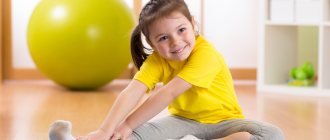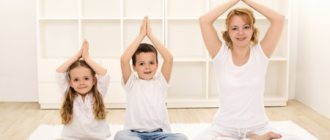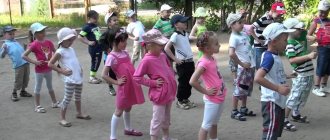Meaning
Morning exercises in the middle group of preschool educational institutions are the main stage in monitoring health.
The purpose of physical education for the child’s body:
- Raising the tone of children physically and emotionally.
- Demonstration of will, since exercises are performed under the guidance of a teacher.
- The whole body is activated.
- Breathing improves.
- Blood circulation accelerates.
- Metabolism improves.
- Introspection of execution.
Note! Gymnastics is carried out under rhythmic audio accompaniment; this develops a sense of rhythm, as children begin to try to fall into the “musical pattern”.
The role of exercise in educational and health processes
The task of morning exercises is to tone the whole body and improve vital processes.
The role of exercise in the health and education of children:
- Physical activity improves blood circulation and oxygen exchange, which stimulates brain activity.
- Muscles are strengthened and overall physical development is activated.
- Systematic exercise leads to strengthening of the body.
Additional Information! Proper combination of physical and mental activity ensures the harmonious development of the child’s personality and character in kindergarten.
Lessons on the street
Methodological techniques with children aged 4-5 years
At 4-5 years of age, the child’s body begins its development, and the child learns to obey collective action. When preparing for classes, the teacher must use special methodological sources describing teaching methods.
The teacher uses the following types of techniques during the lesson:
- verbal;
- visual techniques;
- practical;
- gaming
Additional Information! Gymnastics uses game exercises with elements of performance and music.
Group of verbal exercises
Such exercises will develop vocabulary and teach you how to conduct conversations on simple topics, such as talking about yourself or about recent events. Examples of this type of activity will be presented below.
- Explanation. Must accompany any game action.
- Poems and riddles. “Every morning, my friend, don’t be lazy and hurry up to exercise. We will jump and gallop, raise our palms to the sun.”
- Poetic gymnastics “Berries”. Strawberry is doing the exercises: “Pull your arms higher.” The red raspberry bends: “With exercise, winter colds and even sore throats are not scary.”
- Fairy tales. Fairy tales should have no more than 2 plot twists, so as not to distract children from exercises; it is better to name the characters with memorable names; it is advisable to add illustrated examples.
Note! You can add questions to the stories for group discussion.
Visual
It is easier for children to perceive this world through imaginative thinking, so it is important to use visual examples during the lesson.
It is useful to use the following elements:
- Pictures with animals, toys that will be used as game heroes.
- Illustrations of each element of gymnastics.
- Personal example - the teacher must perform the commented action himself.
Additional Information! If during a lesson the teacher uses a video as an illustration of the exercises, he must repeat all the steps.
Personal example of charging
Practical
This stage occurs after physical education and acts as an independent analysis for children. Their essence is for children to share their emotions after exercises.
Complex 3
- Forming in a line, checking posture.
- Walking on toes.
- Walking on your heels.
- Running like a snake.
- I.p. - basic stance, hands on waist.
- 1 – tilt your head forward, touch your chin to your chest;
- 2 – throw your head back;
- 3 – 4 – similar.
- I.p. - legs slightly apart, hands down.
- 1 – raise your arms up through your sides and clap;
- 2 – i.p.;
- 3 – 4 – similar.
- I.p. - basic stance, hands on the belt.
- 1 – raise your arms up, bend over;
- 2 – bend down and touch your toes;
- 3 – sit down, put your arms forward;
- 4 – i.p.
- I.p. - basic stance, hands on the belt.
- 1 – lunge to the right side, arms to the sides;
- 2 – i.p.;
- 3 – similarly to the left;
- 4 – i.p.
- Walking on toes, hands behind head.
- Walking in a squat, hands on the belt.
- Frog jumps.
- Running with hops.
- Breathing exercise “Clock”.
A set of exercises with a gymnastic stick
- Forming in a column, checking posture.
- Walking while crawling under a stick.
- Running around the perimeter of the hall, bending around sticks placed in its corners.
- I.p. - basic stance, arms down and holding a stick.
- 1 – raise your arms with a stick up above your head and bend over, put your right leg back;
- 2 – i.p.;
- 3 – move your left leg in the same way;
- 4 – i.p.
- I.p. - legs are shoulder-width apart, arms are straight raised above the head and holding a stick.
- 1 – tilt to the right;
- 2 – i.p.;
- 3 – tilt to the left;
- 4 – i.p.
- I.p. - sit on the floor, legs straight, arms in front of you, holding a stick.
- 1 – stretch forward as much as possible;
- 2 – i.p.;
- 3 – 4 – similar.
- I.p. - lie on your back, legs straight, hold the stick in straight hands, behind your head.
- 1 – roll onto your stomach;
- 2 – roll onto your back;
- 3 – 4 – similarly in the other direction.
- Walking while stepping over a stick, which must be held in front of you with both hands.
- Jumping with both feet over a stick lying on the floor (forward - backward).
- Running in a column one at a time.
- Breathing exercise "Mower".
You can perform similar exercises with a jump rope.
Complex 5
- Forming in a column, checking posture.
- Walking with long strides.
- Walking like a duck.
- Running diagonally.
- I.p. - kneel down, hands down.
- 1 – sit on your knees, group yourself (with your forehead touching your knees, stretch your arms forward, put them on the floor);
- 2 – 3 – freeze in this position;
- 4 – i.p.
- I.p. - kneel down, hands down.
- 1 – sit on the floor to the right of your heels;
- 2 – i.p. (you can help yourself with your hands);
- 3 – similarly to the left;
- 4 – i.p.
- I.p. - lie on the carpet, legs straight, arms along the body.
- 1 – raise your right leg and both arms up;
- 2 – i.p.;
- 3 – raise your left leg and both arms up;
- 4 – i.p.
- I.p. - lie on the carpet, legs straight, arms along the body.
- 1 – 3 – raise your bent legs and do a “bicycle” movement;
- 4 – i.p.
- Walking in a circle holding hands.
- Jumping - legs together, legs apart.
- Run backwards.
- Breathing exercise "Locomotive".
Complex 4
- Formation in two columns, checking posture.
- Walking in pairs.
- Jumping on both legs, in pairs, holding hands.
- Running in pairs.
- I.p. - sit on the carpet, legs bent at the knees, hands at the back.
- 1 – 4 – circular turn of the head to the right;
- 1 – 4 – circular turn of the head to the left.
- I.p. - sit on the carpet, legs straight, arms down.
- 1 – lean forward, trying to touch your toes with your hands;
- 2 – i.p.;
- 3 – 4 – similar.
- I.p. - sit on the carpet, legs bent at the knees, hands at the back.
- 1 – raise your right leg, pull your toe up;
- 2 – i.p.
- 3 – raise your left leg in the same way;
- 4 – i.p.
- I.p. - Lie on your back, straight arms behind your head.
- 1 – roll onto your stomach;
- 2 – i.p.;
- 3 – 4 – similar.
- Walking on the inner (outer) side of the foot.
- Running with straight legs.
- Breathing exercise “Trumpeter”.
A set of exercises with a ball
- Forming in a line, checking posture.
- Walking while stepping over balls.
- Running like a snake past the balls.
- I.p. - feet shoulder-width apart, ball in hands.
- 1 – throw the ball, look up at it;
- 2 – catch the ball, lower your head;
- 3 – 4 – similar.
- I.p. - feet shoulder-width apart, hold the ball with straight arms in front of your chest.
- 1 – turn to the right (do not lower your arms);
- 2 – turn left;
- 3 – 4 – similar.
- I.p. - basic stance, ball in right hand.
- 1 – raise both arms up from the sides and transfer the ball to the left hand;
- 2 – lower your hands;
- 3 – 4 – similar.
- I.p. - basic stance, ball in hands, arms down.
- 1 – sit down with your arms extended with the ball in front of you;
- 2 – i.p.;
- 3 – 4 – similar.
- Walk on your toes, hold the ball with straight arms above your head.
- Jumping while holding the ball with your feet.
- Easy running.
- Exercises to restore breathing.
Complex 6
- Forming in a line, checking posture.
- Walking trail after trail.
- Walking on a gymnastic bench.
- Running in a circle with side steps.
- I.p. - sit on your heels, cross your arms over your chest.
- 1 – rise up, spread your arms to the sides;
- 2 – sit on your heels, cross your arms and hug yourself;
- 3 – 4 – similar.
- I.p. - sit on the carpet, legs straight, arms supported behind you.
- 1 – turning around, move your right hand behind your left, stretch;
- 2 – i.p.;
- 3 – turn in the other direction;
- 4 – i.p.
- I.p. - sit on the carpet, legs straight, arms supported behind you.
- 1 – raise your heels without lifting your toes off the floor;
- 2 – i.p.
- 3 – 4 – similar.
- I.p. - lie on your stomach.
- 1 – clasp your ankles with your hands;
- 2 – 3 – raising your legs and upper body, bend over;
- 4 – i.p.
- Alternate running and walking.
- Alternate jumps on the right and left legs.
- Breathing exercise “Mill”.




